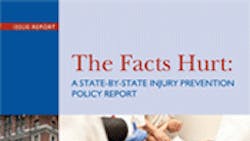The Facts Hurt: Report Ranks U.S. States on Injury Prevention Potential
"The Facts Hurt: A State-By-State Injury Prevention Policy Report," released May 22 by the Trust for America's Health (TFAH) and the Robert Wood Johnson Foundation (RWJF), points out that injuries are the third leading cause of death nationally and are the leading cause of death for Americans between the ages of 1 and 44. Approximately 50 million Americans are medically treated for injuries annually, and more than 2.8 million are hospitalized. Every year, injuries generate $406 billion in lifetime costs for medical care and lost productivity.
In particular, "The Facts Hurt" report focused on vehicle injuries; violence-related injuries; falls, drowning and sports-and-recreation-related injuries; and injuries from poisoning.
"There are proven, evidence-based strategies that can spare millions of Americans from injuries each year," said Jeff Levi, PhD, Executive Director of TFAH. "This report focuses on specific, scientifically supported steps we can take to make it easier for Americans to keep themselves and their families safer."
Safety Indicators
The report ranked states based on a set of 10 indicators. States received one point for achieving an indicator or zero points if they did not achieve the indicator. The indicators include:
1. Does the state have a primary seat belt law?
2. Does the state require mandatory ignition interlocks for all convicted drunk drivers, even first time offenders?
3. Does the state have a universal helmet law requiring helmets for all motorcycle riders?
4. Does the state require car seats or booster seats for children to at least the age of eight?
5. Does the state require bicycle helmets for all children?
6. Does the state allow people in dating relationships to get protection orders?
7. Did the state receive an “A” grade in the teen dating violence laws analysis conducted by the break the cycle organization?
8. Does the state have a strong youth sports concussion safety law?
9. Did the state enact a prescription drug monitoring program?
10. Did more than 90 percent of injury discharges from hospitals receive external cause- of-injury coding in the state, which helps researchers and health officials understand injury trends and evaluate prevention programs (2009 data)?
Montana and Ohio ranked the lowest with a score of 2; Idaho, Kentucky, North Dakota, South Carolina, South Dakota and Wyoming earned 3 points; and Michigan, Mississippi, Nevada and New Hampshire received 4. On the other end of the spectrum, California and New York ranked the highest with 9 points. Maryland, North Carolina, Oregon, Rhode Island and Washington followed with 8 points each.
Key findings include:
· 29 states do not require bicycle helmets for all children;
· 17 states do not require that children ride in a car seat or booster seat to at least the age of eight;
· 31 states do not require helmets for all motorcycle riders;
· 34 states and Washington, D.C. do not require mandatory ignition interlocks for convicted drunk drivers;
· 18 states do not have primary seat belt laws;
· 44 states scored a "B" or lower on a teen dating violence law review by the Break the Cycle organization; and
· 13 states do not have strong youth sport concussion safety laws.
Accident and Injury Prevention
The report also ranked states based on fatalities caused by injuries. Nationally, 57.9 per 100,000 Americans die in injury-related fatalities. The report found that New Mexico's rate of 97.8 injury-related deaths per 100,000 people is the highest in the nation, followed by Montana with a rate of 86.5; Alaska at 85.8 and Wyoming with a rate of 84.7. New Jersey had the lowest rate at 36.1 per 100,000, followed by New York at 37.1, Massachusetts at 41.1 and California at 47.6.
The report makes various recommendations to improve injury prevention within states, including additional resources for injury prevention; increased investment for injury prevention research; and stronger partnerships between public health and other sectors.
"By adopting policies and laws based on these proven approaches, policymakers can help lower the number of injuries in their states, counties and cities," the report states.
View the full report, including all state rankings and safety recommendations, at http://healthyamericans.org/reports/injury12/.
About the Author

Laura Walter
Laura Walter was formerly senior editor of EHS Today. She is a subject matter expert in EHS compliance and government issues and has covered a variety of topics relating to occupational safety and health. Her writing has earned awards from the American Society of Business Publication Editors (ASBPE), the Trade Association Business Publications International (TABPI) and APEX Awards for Publication Excellence. Her debut novel, Body of Stars (Dutton) was published in 2021.
